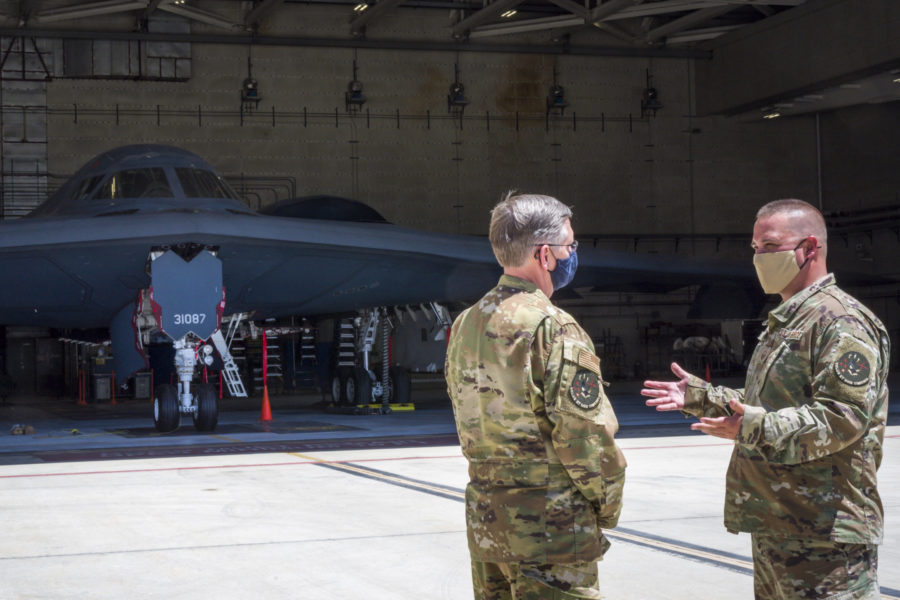As the first flight of the B-21 Raider bomber draws closer, Gen. Timothy M. Ray, head of Air Force Global Strike Command, toured Northrop Grumman’s production facility and the test enterprise that will put the jet through its paces beginning next year.
Ray saw “significant progress made on the build of the first flight test aircraft that will one day make its way to Edwards Air Force Base, [California], for testing,” said the Rapid Capabilities Office, which manages the B-21 program, in a press release.
The RCO said flight testing of the new bomber will begin as soon as aircraft No. 1 is complete, and this will be driven by “key maturity events” and not “arbitrary dates.”
Randall G. Walden, head of the RCO, told Air Force Magazine that he expects the B-21 to emerge from the factory in early 2022 and make its first flight about a year from now. First flight will be preceded by outside engine runs and taxi tests of increasing speed.
Ray started his tour of the bomber test enterprise on May 5 with a visit to the 419th Flight Test Squadron, Global Power Combined Test Force. The unit performs tests on the B-1, B-2, and B-52 bombers. It is also already performing tests on the AGM-183A Air-launched Rapid Response Weapon, a hypersonic missile that will equip the B-52 and eventually the B-1 and F-15. Ray has said as many as a dozen B-52s and B-1s could be involved in testing new weapons for the bomber fleet.
Continued B-2 testing “enables expanded strike capabilities while ensuring the aircraft can keep pace with evolving threat levels,” the RCO said.
Ray also visited the B-21 Combined Test Force comprising the 420th Flight Test Squadron and Detachment Five of the Air Force Operational Test and Evaluation Center (AFOTEC), plus B-21 prime contractor Northrop Grumman. He was briefed on “readiness to support the B-21 program when it transitions into flight test.”
On May 6, Ray toured the Northrop Grumman facility at Plant 42 in Palmdale, California, where the B-21 undergoes final assembly. Ray was briefed on construction of the first two test aircraft and “the value of building those test articles using the same production line, tooling, and procedures that will manufacture the final production aircraft.”
The RCO echoed what Walden told Air Force Magazine: that the production managers are applying lessons learned from building the first two aircraft “to implement process improvements well before building the actual operational aircraft, decreasing cost and build schedule.” Stable requirements and a risk-reducing strategy “have played a large part in keeping the program schedule on track to deliver operational B-21 Raiders to the first main operating base in the Mid-2020s.” Ellsworth Air Force Base, South Dakota, is to be the Raider’s first beddown and operating location.
House Armed Services Committee chair Adam Smith (D-Washington) recently made an uncharacteristically positive assessment of the B-21’s progress, calling an April briefing he received on it “one of the most positive, encouraging things I’ve had happen to me in the last couple of weeks.” He said the B-21 is “on time, on budget, and they’re making it work in an intelligent way.” The B-21 and other programs are “starting to see the lessons learned” over two decades of frustrating weapons development, and the “necessary changes” in the acquisition system are starting to bear fruit, Smith said.
Due to secrecy, and to prove out a more streamlined approach, the B-21 program is being run by the RCO rather than Air Force Materiel Command, which would normally run a major program for the service.
Collaboration between the Air Force Operational Test and Evaluation Center, AFGSC, Air Force Materiel Command, and the RCO “has paved a smooth path for transition into the critical flight test phase” of the B-21, said Maj. Gen. Christopher P. Azzano, commander of the Air Force Test Center at Edwards. He called it “an extraordinary team effort.”
The RCO quoted B-21 system program director Col. Jason Voorheis as saying the Air Force is “pleased” with the B-21’s progress and that the service and Northrop Grumman are “working closely together to make smart choices on this program to support warfighter requirements and timelines.”
